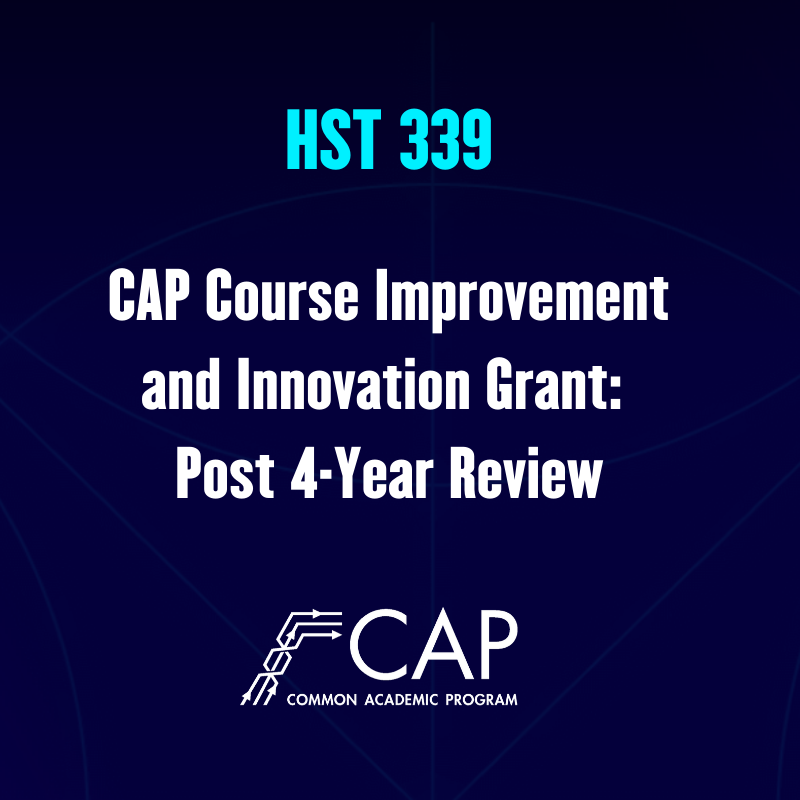LTC

Changing Course! (Pun Intended)
In Fall 2018, the Provost’s Office, Ryan C. Harris Learning Teaching Center, and CAP Office launched a new grant program – CAP Course Improvement and Innovation: Post 4-Year Review – to support faculty who are working to improve some aspect of their CAP course related to insights gleaned during the review process. Associate Professor of History Haimanti Roy provided the following description of her grant project for HST 339.
In November 2018, when I received a CAP Course Improvement and Innovation: Post 4-Year Review grant to revise my course HST 339: Gandhi’s India, I had a somewhat clear idea of what I wanted to do with the course from that point forward. After all, I had written a successful grant proposal which seemed to support that idea. Plus, the initial proposal had included some easy fixes – changing the course title from Gandhi’s India to Gandhi, Nonviolence, and Resistance Around the World to better reflect the course content and reducing the number of course learning objectives, which would allow the course to achieve those objectives. The 4-Year Review process had been a timely reminder to get back to the drawing board, and I was eager to revise the course substantially. Further, it was clear to me that the course content was already aligned with the Diversity and Social Justice component in CAP, though HST 339 was initially approved only for Advanced Historical Studies. I needed to do something so that students would also get DSJ credit for it.
But this was as far as the easy part went. When I finally sat down to think through the process in the summer and fall of 2019, implementing the core of the revisions – creating a more experiential component for the course – in ‘real terms’ did not look that easy. I had proposed to develop course content which would be better aligned with the Institutional Learning Goals (ILGs) of Scholarship, Diversity, and Critical Evaluation of Our Times. To achieve these, I had planned to develop research ‘starter kits’ which would have individualized material for students to work on projects connected with histories of non-violence, passive resistance, and nationalisms on the one hand, and be able to incorporate themes of social and gender justice, race, law, and citizenship on the other hand. I am often asked by presses to review primary source collections/compendiums/ introductions to BIG topics which generally tend to compile a similar range of materials at one place, making them accessible to students. Some of these collections that I have reviewed were excellent and gave me the initial idea to do something similar for the course so that students would already have something to work with early in the semester.
However, this was quite ambitious on my part to think that I would be able to incorporate all of these into such starter kits. One of the key issues was the availability of visual material and primary sources in English that would reflect the global breadth of the course. The University Libraries don’t have access to all of the publications and materials I had hoped to use. Luckily for me, Gandhi’s writings (around 100 volumes) are available online and are in English, and UD has access to the London Times. I have also begun compiling my own personal collection of visual material, primary source documents, and secondary readings which I can share with students via Isidore. The library staff has been incredibly helpful in accessing material from the Center for Research Libraries, OhioLINK, Hathi Trust, etc. And thanks to the generosity of the CAP Leadership Team (CAPL) awarding the grant, I was able to purchase a few relevant DVD titles to plug the gap in visual materials.
I have created two starter kits so far, and I hope to create at least four more in the coming months. During the semester, students develop three interrelated project submissions – annotated bibliography, introductory arguments, and draft – before the final project is due. I hope to use a staggered method to track the usefulness of these kits – are students using and further developing on the primary source materials listed in the kits? What new sources have they brought on their own to further their project and show off their research skills? Are they able to critically analyze these sources, and how are they developing a particular line of argument?
I am still in the process of developing connections beyond the classroom with the Fitz Center for Leadership in Community and the Dayton Peace Museum. But I am also changing course from what I had proposed (as is the fate of all proposals!) – I am now hoping to develop a two-week Study Abroad component in South Africa (in collaboration with the Center for International Programs, CAS dean’s office and my department) that would give the students an immersive experience in the land of Mandela and Gandhi immediately after they have taken the semester-long course.
